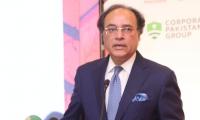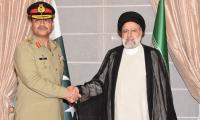Post-retirement, after a brief stint at diplomacy, I joined the bandwagon of peaceniks. A leopard hardly changes its spots but try I did. For more than seven years I, with other colleagues, met my counterparts from the academic, diplomatic and the military worlds from India on regular intervals – sometimes seven to eight times a year – in different compositions grappling with the issues that plagued the relationship between India and Pakistan.
We agreed to place Kashmir on the back-burner; we gave eminence to terrorism as India’s preferred topic of discussion and even played around with Musharraf’s four-points, or NS’ Chenab formulation, and looked at accepting the LoC as a permanent border, something India always relished but shrunk away from as soon as we showed willingness for it to be discussed; never sure if Pakistanis were playing a trick gaining them more advantage than India could fathom.
We discussed nuclear doctrines and the associated concerns threadbare; even as much as formulating likely doctrines of strategic application. We reached a consensus on Siachen, and the modalities of its operationalisation, but then the Indians shrank away from it too under immense domestic pressure of its own political and military establishment. Those who agreed on a consensual modus operandi to resolve Siachen were hounded, and later excommunicated in Delhi, promising never again to venture on that road. If Siachen could have been done, Sir Creek was already done.
These two out of the way, we could have then spent our energies on any of the floating mechanisms to do Kashmir. But the Indian establishment simply could not dare itself to break its own stranglehold. In each of these cases the Pakistanis were the most enterprising, ever ready to think anew, and move things forward even if it meant moving away from its stated positions. Whenever we came back and fed our conclusions into the regular Pakistani establishment, political or military, we were never discouraged. India was another story. We have since lost those years and the effort spent at moving on beyond what has held us back.
The year 1971 was a bad one, perhaps the most tumultuous in terms of its adverse impact on Pakistani psychology and mental make-up. Pakistan was broken into two, losing half of it to India in a war. It seems crass but there is no other way to put it. This had been preceded by a surreptitious Indian intervention in East Pakistan where over years a sentiment of hate and an army of dissidents was prepared, trained and unleashed against the Pakistani administration in East Pakistan. Pakistan’s own political make-up was no less instrumental in making that possible.
India followed this in 1983 against Sri Lanka, creating, supporting and sustaining the Tamil Tigers, at that time the most ruthless terror organisation in the world. If using irregulars as rebels and creating terror groups was first introduced by a nation it was thence, by the Indian government and its military as national policy. Narendra Modi publicly boasted of it most recently in Dhaka.
In 1974 India exploded a nuclear device. A vanquished Pakistan was forever crestfallen. The Indian domination was complete changing the strategic calculus between the two forever. But then luck and a lots of grit helped. Pakistan stood up, gathered itself under ZAB, announced its entry into the world in its new avatar, and went on to develop its own nuclear equivalence. By 1984 Pakistan had a bomb. India’s nuclear domination was neutralised. A new strategic reality governed South Asia. By 1998, it all got firmly and formally rooted. India would not be the hegemon in South Asia.
The 1979 was remarkable too. The Soviet Union rolled into Afghanistan and threatened to roll back the existing order so firmly established since WWII. Soon the US moved in through Pakistan to counter the Soviets and gave birth to what was to later plague the region perennially: the mujahideen, the prototype Taliban – the Islamic guerrilla who would counter the Soviet onslaught. After a ten-year long struggle, the mujahid won and the Soviet Union was demolished. Quite conveniently, the US left both the baby and the bath water in Pakistani hands and decamped. But it left Pakistan with the wherewithal and the idea of using irregulars as a force multiplier.
The possibility of a war pervasive, given that zero movement had taken place on the political front to resolve their lingering issues, the use of the non-state actor afforded a strategic cut-out between full-on conventional wars between the two nations. The perversity is obvious, but the ‘irregulars’ have kept the two from a direct steel-on-steel confrontation as had been the norm till 1990.
In 1990, Pakistan allegedly stirred the Kashmir pot with some of the released irregulars from Afghanistan. It went on for a while till it all became quiet again in 1996. The year 1998 brought the nuclear reality to South Asia and all went back to the drawing board. Instead of forging cooperative mechanisms under the newer realities and challenges, sub-national wars took hold. Both nations entered a phase of being in a war while not being in a war. India’s PM has since confirmed using the same tactics against Pakistan in Fata, Balochistan and Karachi.
Come 2016, and another phase of fourth generation warfare. Parts of western Pakistan blew up as did Indian-occupied Kashmir along with a concurrently running intifada by the Kashmiri freedom fighters. Unable to control the valley, India resorted to upping the ante against Pakistan and the dangers of conflict hovered once again; this time between two nuclear neighbours.
Reactions within Pakistan have been varied. While India has launched parallel offensives politically and diplomatically, it has threatened military action too by pinning blame on Pakistan for militancy in Kashmir. Pakistan has denied this vehemently, but has also been forced to introspect to obviate the cleavages that give cause for others to suspect a Pakistani hand for anything that goes wrong in India. While having been in a long war against terror groups targeting Pakistan over this entire period it has in earnest decided to eliminate any remnants that may have earlier had some connection with militancy in Kashmir as well. This is a major policy shift enunciated clearly by the political and military establishment. Such strategic correction of the course though has its consequences.
One, the Kashmir issue remains unresolved. Two, the Kashmiris are divested of any support, psychological or material, that may have helped them sustain their struggle. Three, with the wounds of unresolved issues still festering, the chance of a regular conventional war becomes a possibility. Four, such a war will easily degenerate into a nuclear exchange due to escalatory consequences. Five, India, unchecked and relentless, will once again dominate and drive South Asia at its whims. And six, a South Asia that has known peace through a strategic balance along the full spectrum will stand denuded of such assurance.
Unless an international mechanism is invoked right away and issues such as Kashmir and those that plague India-Pakistan are addressed, the region stands closer to a conventional-nuclear conflict. What the non-state actor first absorbed will now lie in the fold of the state to respond to. That only means a certain slide into annihilation. The two countries desperately lack a conflict-containing mechanism and only depend on the rationality of opposing actors to avoid an Armageddon.
Without a dialogue and without an international compact to address the underlying issues, the region is nowhere close to finding stability. Both India and Pakistan will do well to heed its imminence.
Email: shhzdchdhry@yahoo.com
An aeroplane of the national flag carrier of Pakistan is seen in this file photo. — AFPWhile Pakistan considers...
Representational image of a graph depicting various variables. — APP/FileInitiated by the centre and fiercely...
In this picture taken on April 16, 2023, people throng a market area during shopping in Lahore. — AFPOne of the...
Honour crimes also target men. In Sikandar Ali Lashari vs The State, SHC upheld conviction passed by ATC for honour...
If Sindh earmarks Rs20 million per police station, it will cost only Rs10 billion to make them effective first...
A complex and difficult policy environment seems to be highlighted by US’s recent application of sanctions on...







